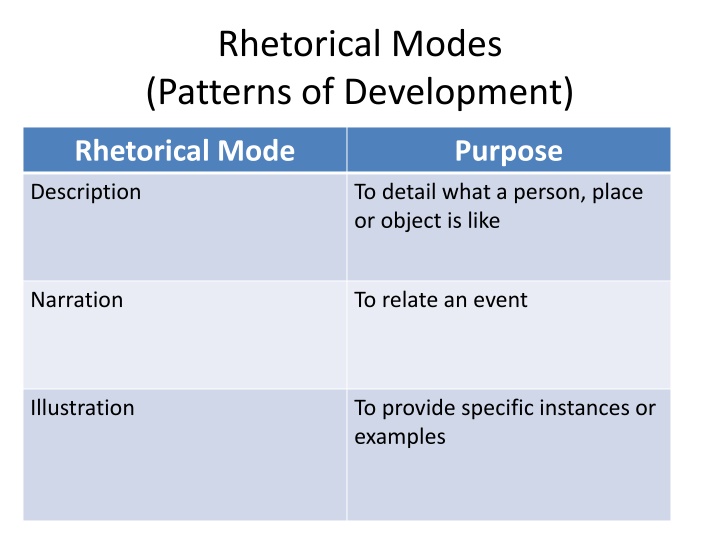
Rhetorical Modes in Writing - Patterns of Development and Purpose
Explore the various rhetorical modes in writing, including narration, illustration, division-classification, process analysis, comparison/contrast, cause-effect, definition, and argumentation. Discover how these modes are applied through examples and evidence, with insights on babysitting scenarios and caregiver interactions.
Download Presentation

Please find below an Image/Link to download the presentation.
The content on the website is provided AS IS for your information and personal use only. It may not be sold, licensed, or shared on other websites without obtaining consent from the author. If you encounter any issues during the download, it is possible that the publisher has removed the file from their server.
You are allowed to download the files provided on this website for personal or commercial use, subject to the condition that they are used lawfully. All files are the property of their respective owners.
The content on the website is provided AS IS for your information and personal use only. It may not be sold, licensed, or shared on other websites without obtaining consent from the author.
E N D
Presentation Transcript
Rhetorical Modes (Patterns of Development) Rhetorical Mode Purpose Description To detail what a person, place or object is like Narration To relate an event Illustration To provide specific instances or examples
Modes Rhetorical Modes Purpose Division-Classification To divide something into parts or to group related things into categories. Process analysis To explain how something happens or how something is done. Comparison/Contrast To point out similarities and/or dissimilarities
Modes Rhetorical Modes Purpose Cause-Effect To analyze reasons and consequences Definition To explain the meaning of a term or concept Argumentation To win people over to a point of view
Rhetorical Modes Evidence Generated Description Details about a child who, while being babysat, was badly hurt playing on a backyard swing. Narration Story about the time a friend babysat a child who became seriously ill and whose condition was worsened by the babysitter s remedies Illustration Examples of potential babysitting problems: an infant who rolls off a changing table ; a toddler who sticks objects into an electric outlet; a school-age child who is bitten by a neighborhood dog. A typical babysitting evening divided into stages: playing with the kids; putting them to bed; dealing with their nighttime fears once they re in bed. Classify the different types of fears Division-classification
Rhetorical Modes Evidence Generated Process Analysis Step-by-step account of what a babysitter should do if a child becomes ill. Comparison-contrast Contrast between two babysitters: one well prepared, the other unprepared Cause and Effect Why children have temper tantrums; the effect of such tantrums on an unskilled babysitter Definition What is meant by a skilled babysitter Argumentation-persuasion A proposal for a babysitting training program to be offered by the local community center.
Citation: Nadel, Langan, Comodromos. The Longman Writer Seventh Edition 2007.
